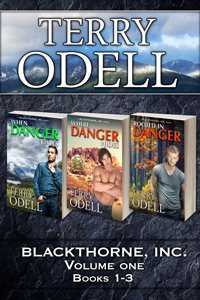It’s a Touching Good Story
Terry Odell
 Use the five senses in your writing. We’ve all heard it. Often, writers consider that a ‘rule’ and try to incorporate all five into every scene. For me, that inches into “laundry list” territory. I liked David Morrell’s approach, which was to assume sight is a given and include two others, varying them across the scenes.
Use the five senses in your writing. We’ve all heard it. Often, writers consider that a ‘rule’ and try to incorporate all five into every scene. For me, that inches into “laundry list” territory. I liked David Morrell’s approach, which was to assume sight is a given and include two others, varying them across the scenes.
I’ve already talked about the senses of sight and smell. What about touch? It’s an important sense—and a very interesting one. Do your characters utilize it? Notice it? React to it?
What are some ways you can use the sense of touch in your writing?
Common sensations for your characters:
Weight. Heavy or light? Can it be unexpected? My marine mammal specialist Hubster was big into bones. A manatee rib is amazingly heavy for its size. When people pick it up, they’re always compensating as their senses readjust.
Smooth or rough?
Bumpy or deep indentations?
Solid, or does it give?
Warm, hot, or cold?
How does your character react if they come into contact with something painful?
Side note: Our nervous system includes a ‘shortcut’ to react to pain. Grab that hot pan on the stove by mistake? Ever notice that your hand jerks away before you feel the pain? That’s because you’ve got nerve pathways to the spinal cord that cause your muscles to contract while the sensation is still working its way up to the brain, which then interprets the feeling as pain, and that’s when you say ouch. Meanwhile, you’ve avoided potential damage.
 Are you describing the sensations of walking barefoot through the mud? Trying to get a handhold on a slick surface? What about on the rough stones as the character tries to climb to safety?
Are you describing the sensations of walking barefoot through the mud? Trying to get a handhold on a slick surface? What about on the rough stones as the character tries to climb to safety?
How do you describe the sensations? Need a prompt or two? Here are over 200 descriptive words.
If you’ve got your character in the dark (eliminating the sense of sight), touch becomes more predominant. But, dark or not, your characters can feel the stickiness of a bloody wound, the roughness of the ropes they’re tied up with, the warmth of another character’s hand, the hardness of the chair they’re sitting in.
 Perhaps more important is that there are two systems of touch. One is the obvious factual description. The chair in the interrogation interview room (have to keep up with the terminology) is cold, hard, and off balance. But there’s also the emotional side of the sense of touch.
Perhaps more important is that there are two systems of touch. One is the obvious factual description. The chair in the interrogation interview room (have to keep up with the terminology) is cold, hard, and off balance. But there’s also the emotional side of the sense of touch.
There are completely different sensors for physical touch vs emotional touch.
If all you’re writing is what that interview room chair feels like as the character sits there, you’re missing an important way to connect with your readers. Does it trigger a visceral reaction as well as a physical one? Let the readers in on it. Maybe instead of the fear or at least the mental discomfort the cop his hoping for, what if the chair evokes happy memories of sitting at the boisterous kids table at Thanksgiving with all his cousins, joking, flipping mashed potatoes across the room at Great Aunt Martha?
When your character picks up a firearm, it might be feel cool, hard, maybe the grip is rough in his palm. Does picking up the weapon give him a sense of power? Of calmness, knowing he’s now in charge? Or is it an unwelcome foreign object? Something the character has no desire to hold, to be in the same room with, but he now needs it for survival? Or to defend someone he cares about? What emotions would those same sensations trigger in him?
Romance writers might have an edge over mystery writers here, since they’re used to showing emotion, and touch is very important to creating a bond between people. And yeah, it plays a part in sex. Even if you don’t like sex scenes on the page, there’s a lot of touching in foreplay. Touch is connected to the release of pheromones. While for men, it’s the sense of smell that triggers them, for women, it’s physical contact with the partner.
Other interesting facts about the emotional side of touch. An experiment showed that people holding hot drinks when meeting someone rated them warmer, as having a more pro-social personality than if they were holding cold drinks.
Another experiment had people evaluating resumes of others. Resumes on a heavy clipboard resulted in people being considered as having more authority. Not that they would be better in the job, but just more weighty.
Remember, senses don’t exist in a vacuum. The feel of rough burlap when the bad guy puts a hood over his victim will intersect with the sense of smell. Use both to add depth to your story.
Your turn, TKZers. How do you incorporate the sense of touch in your books? Do you connect them to the emotional side? The floor is yours.
Some references for this post:
For more about the science of touch, go here.
For more about incorporating touch into writing, go here.
 If you’ll permit a brief moment of BSP, in anticipation of releasing Cruising Undercover, Book 11 in my Blackthorne, Inc. series, the first box set of Blackthorne, Inc. novels, including When Danger Calls, Where Danger Hides, and Rooted in Danger, is on sale for 99 cents this week. Price goes up on July 27th.
If you’ll permit a brief moment of BSP, in anticipation of releasing Cruising Undercover, Book 11 in my Blackthorne, Inc. series, the first box set of Blackthorne, Inc. novels, including When Danger Calls, Where Danger Hides, and Rooted in Danger, is on sale for 99 cents this week. Price goes up on July 27th.
 Now Available for Pre-Order: Cruising Undercover.
Now Available for Pre-Order: Cruising Undercover.
Not accepting the assignment could cost him his job. Accepting it could cost him his life.
 Terry Odell is an award-winning author of Mystery and Romantic Suspense, although she prefers to think of them all as “Mysteries with Relationships.”
Terry Odell is an award-winning author of Mystery and Romantic Suspense, although she prefers to think of them all as “Mysteries with Relationships.”

Thanks, Terry, for a wonderful post, and the links. Great!
Upon quick reflection, I think that I typically incorporate touch as an analogy, or as a trigger for memory of the past. I try to put myself into the scene and imagine everything I see, hear, feel, smell, and taste. The emotional side of tactile sensations? I’m going to work on that one.
Thanks for a great physiology lecture, Prof. Terry. Good stuff!
You’re welcome, Steve. I learned a lot, too.
Love the science beyond touch, Terry. Fascinating. But I wouldn’t say mystery and thriller writers don’t include emotion. Far from it. Readers tell me my books are emotional roller coasters, and I write psychological thrillers.
I didn’t mean to say there’s no emotion in mysteries, but I’m not sure how many mystery authors show the visceral and/or physiological responses to touch for their characters. Kudos to those who do.
This is excellent advice. I’ve read way too many scenes that begin with exactly 5 sentences, each describing one of the senses. Ugh!
One thing that (I believe) really helped my writing was JSB’s quote from Raymond Carver to focus on a “telling detail.” That’s stayed with me.
Glad you found it helpful, Philip. I agree that laundry lists don’t make for good reading. That ‘telling detail’ is good advice.
Good post, Terry! In a grim and gritty passage (in an upcoming release), my mc is wearing jellies. The grit of the desert sand scrubbed her skin raw.
Thanks, Priscilla. How does that sensation affect her emotional state? That could add more character depth.
My mc feels raw and vulnerable.:-)
Very informative, Terry. And the science of touch article you linked to was fascinating. I can see lots of applications for this in my writing.
I’ve noticed a tactile influence when I’m working on a story and I put post-it notes on the 3-door (3-act) closet in my office. Somehow I’m more connected to the story when I’m standing in front of those doors moving the post-it notes around than if I did the same thing electronically.
I just grabbed the box set and I’m looking forward to your latest book. Best wishes with all of them.
Thanks, Kay. Hope you enjoy meeting the Blackthorne teams. Your example of post-it notes is why I prefer using them to record scene notes, etc., over Scrivener, which is just another computer-using process. Writing things out by hand creates another pathway to the brain. I stick mine on a foam core board, so I can move it to another room, another way to ‘see’ things differently.
Terrific post, Terry. I saved the 200+ touch descriptors and the fascinating science article.
I try to incorporate physical sensations with emotional ones. In my WIP, a character is tied up in a car trunk with gritty carpet scraping his cheek. His foot cramps as he’s feeling for the T-shaped lever to release the back seat. But he’s more angry than scared.
A sensation I like to use in foreplay is the feeling of the lover’s breath in a character’s hair or tickling the ear.
Glad you enjoyed the post, Debbie. Thanks for sharing your examples. Showing anger instead of the expected emotion of fear is a good way to reveal the character.
I do think touch and smell are underutilized in genre fiction. Sol Stein advised at least one sensory detail on each page. I like that.
I like that, too, JSB. As long as we remember not to fixate on one sense. 🙂